One of the tough things about Disney history is determining the abilities of the directors. Walt Disney was always the final arbiter of anything that went on the screen. How much of what we see in the Disney shorts of the 1930's is the work of the directors and how much is Walt Disney or the crew?
In Burt Gillett's case, we have a pretty good idea. At Disney, Gillett directed some fairly notable cartoons: Flowers and Trees, The Three Little Pigs, Mickey's Gala Premier, Playful Pluto, Lonesome Ghosts and The Brave Little Tailor. Walt Disney obviously had faith in him or he wouldn't have assigned him such important cartoons.
Other studios were interested in Gillett because The Three Little Pigs was one of the most successful short cartoons ever made. The Van Beuren studio hired Gillett to upgrade their films. While today we have a fascination with the quirkiness of the Van Beuren cartoons from the early '30's, at the time the studio was stuck with a silent cartoon drawing style and unable to create popular characters.
Gillett converted the studio to color production, upgraded the drawing and bought rights to characters like Felix the Cat and Toonerville Folks. The studio created original characters like Molly Moo Cow. If you've seen these cartoons, they're far slicker than Van Beuren's earlier films but they still lack strong stories and characters. When Disney made a deal to distribute through RKO, RKO dropped the Van Beuren cartoons and the studio closed.
Gillett returned to Disney for a couple of years but left again in 1938 when he moved to the Walter Lantz studio. He worked on the first few Andy Panda cartoons and a couple of fairy tale spoofs, but his cartoons at Lantz resemble his Van Beuren work far more than they do his work at Disney.
While Gillett was present at the birth of personality animation at Disney, I don't think that he really understood it. The ghosts in Lonesome Ghosts are interchangeable in a way that the three pigs are not. The giant in The Brave Little Tailor is thinly conceived; he's not as interesting as the big bad wolf. With the possible exception of Andy Panda, Gillett wasn't involved with a successful character outside Disney, and Andy was stolen from Fannie Brice's radio character Baby Snooks.
In his biography The Walter Lantz Story, Joe Adamson quotes Lantz saying, "Burt had to do things over and over and over again. He was a trial-and-error person....Gillett never knew where he was going." It took Disney and his story department to give Gillett something to run with. Away from Disney, he couldn't manage it himself.
Gillett left the animation business in 1940 but lived until 1971, dying at the age of 80. I have no idea what he did after leaving animation, but I'd be curious to find out.
Showing posts with label The Brave Little Tailor. Show all posts
Showing posts with label The Brave Little Tailor. Show all posts
Friday, July 14, 2006
Wednesday, July 12, 2006
The Brave Little Tailor Part 3
It's interesting that two of the animators most closely identified with Mickey, Les Clark and Fred Moore, have so little to do in this cartoon. I have to assume that they were busy on other films. It's likely that Moore was working on the version of Pinocchio that was scrapped.
As in Mr. Duck Steps Out and The Little Whirlwind, Clark gets the entrance of the main character. I'm sure that he earned those opportunities through the quality of his work. The scene of Mickey swatting the flies contains some lovely, subtle distortions of Mickey's head and hands when he first goes after the bugs.
Moore has a couple of scenes and scene 45 is the best, with some nice acting. Mickey has to put on a brave face for Minnie, but his real feelings come out as soon as he turns away from her. It's interesting to see how Moore's Mickey is shorter and squatter than Frank Thomas's.
Ollie Johnston gets the montage sequence after Mickey swats the flies. It's more action than acting, but it's vigorously animated and the drawings are solidly proportioned even when the characters are moving in perspective. Ollie also gets a couple of Mickey scenes. 73A looks like it was added as an afterthought to focus the audience on Mickey pulling out his needle. There's a continuity error on the width of the thread between this scene and the Roy Williams scenes that bookend it.
Riley Thomson's king has a wonderful fleshiness to his jowls and great follow through on his robes. While Frank Thomas takes over the king once Mickey arrives, I think that I like Riley Thomson's version better. It has a greater presence. Thomson also gets some scenes of Mickey; there's good acting in scene 48 and a great scramble exit in 49A.
Don Patterson seems to get the short end of the stick in this cartoon, getting stuck with crowd scenes and long shots. He went on to do great animation at MGM, but it looks like the Disney studio didn't trust him with big scenes at this point.
Roy Williams does the scenes of Mickey inside the giant's mouth. That's imagery worthy of the Fleischer cartoons of the early '30's and it's helped along by excellent effects animation by Cornett Wood.
This is the last Disney cartoon directed by Burt Gillet to be released. I want to talk about him in a future entry.
As in Mr. Duck Steps Out and The Little Whirlwind, Clark gets the entrance of the main character. I'm sure that he earned those opportunities through the quality of his work. The scene of Mickey swatting the flies contains some lovely, subtle distortions of Mickey's head and hands when he first goes after the bugs.
Moore has a couple of scenes and scene 45 is the best, with some nice acting. Mickey has to put on a brave face for Minnie, but his real feelings come out as soon as he turns away from her. It's interesting to see how Moore's Mickey is shorter and squatter than Frank Thomas's.
Ollie Johnston gets the montage sequence after Mickey swats the flies. It's more action than acting, but it's vigorously animated and the drawings are solidly proportioned even when the characters are moving in perspective. Ollie also gets a couple of Mickey scenes. 73A looks like it was added as an afterthought to focus the audience on Mickey pulling out his needle. There's a continuity error on the width of the thread between this scene and the Roy Williams scenes that bookend it.
Riley Thomson's king has a wonderful fleshiness to his jowls and great follow through on his robes. While Frank Thomas takes over the king once Mickey arrives, I think that I like Riley Thomson's version better. It has a greater presence. Thomson also gets some scenes of Mickey; there's good acting in scene 48 and a great scramble exit in 49A.
Don Patterson seems to get the short end of the stick in this cartoon, getting stuck with crowd scenes and long shots. He went on to do great animation at MGM, but it looks like the Disney studio didn't trust him with big scenes at this point.
Roy Williams does the scenes of Mickey inside the giant's mouth. That's imagery worthy of the Fleischer cartoons of the early '30's and it's helped along by excellent effects animation by Cornett Wood.
This is the last Disney cartoon directed by Burt Gillet to be released. I want to talk about him in a future entry.
Tuesday, July 11, 2006
The Brave Little Tailor Part 2
I should have mentioned yesterday that this cartoon is available on the Walt Disney Treasures set Mickey Mouse in Living Color. It's one of the most common Disney cartoons, so I'm assuming that it's out there on other DVD's as well.
By the time The Brave Little Tailor was made, it was rare that Mickey was in a cartoon that didn't include Donald Duck and Goofy. It was rare, too, for the cartoon to be so adventure oriented. In many ways, this cartoon is a throwback to Mickey's glory years of 1932-34, but the film benefits from the addition of color and the increased skills of the artists. It's important to remember that this cartoon was made after Snow White and the Seven Dwarfs, so it reflects the advances made in the feature.
There are two star turns here in the animation. The first is the sequence by Frank Thomas, where Mickey describes killing seven with one blow and then reacts to the king's order to kill the giant. While Mickey gets intercut with the king, it's really a soliloquoy and Thomas takes advantage of a great voice track provided by Walt Disney. It's also funny to see how Mickey exaggerates the story beyond the mundane swatting we see at the start of the cartoon.
Thomas really excels at getting expressive poses here. He uses moving holds beautifully to make sure that those poses read clearly. He contrasts fast and slow movements for variety, but no matter what Thomas is doing, he never loses the audience. That's a lesson that's often forgotten today. While Thomas has dialogue to work with, the poses and timing perfectly convey Mickey's story even without sound. It's a great piece of acting and one of Mickey's best sequences ever.
The other star turn is Tytla's sequence with the giant. I'm going to catch flak for saying this, but I think that it's a disappointment. The failure is not Tytla's, it's the way the giant character has been conceived. There's very little personality here. The giant is large and slow-witted, but that's all we get. Compared to Willie, the giant in Fun and Fancy Free, this giant is frankly dull.
This is a wasted opportunity as Tytla has shown what great acting he is capable of with Grumpy in Snow White. While Tytla's drawing always has great physicality, he needs a fully developed personality who goes through a series of emotions to showcase his acting ability. While Tytla's draftsmanship is a great tool, it needs to be applied to a great character. The giant is not such a character.
Probably the two best scenes are 70 and 72. The first showcases anger and the second anger and frustration. Give Tytla strong emotions and he'll rise to the occasion. But the early scenes with the giant just have him out for a walk, a snack and a smoke, hardly the stuff of drama.
Thinking about Tytla, it may be that his best work didn't rely on his ability to portray power. Grumpy and Dumbo are not physically overpowering characters, yet they're completely successful. Stromboli requires Tytla's physicality but also calls on his acting skills. In my opinion, and I know that some will disagree, Chernobog in Fantasia, the Nazi teacher in Education for Death, and this giant all call on his draftsmanship but are too simply conceived at the script stage to give Tytla something to sink his teeth into.
It's frightening to me that they didn't seem to realize this at Disney. They wasted Tytla a good percentage of the time and if Disney didn't know how to play to Tytla's strengths, forget about Terrytoons or Famous Studios. As I said here, nobody at those studios thought in terms that were sympathetic to Tytla's skills.
(For a look at stills of Tytla's work at Terrytoons, see this post by Duck Dodgers. There are other Tytla posts on his blog as well.)
I'll talk about the rest of the animation in a future entry.
By the time The Brave Little Tailor was made, it was rare that Mickey was in a cartoon that didn't include Donald Duck and Goofy. It was rare, too, for the cartoon to be so adventure oriented. In many ways, this cartoon is a throwback to Mickey's glory years of 1932-34, but the film benefits from the addition of color and the increased skills of the artists. It's important to remember that this cartoon was made after Snow White and the Seven Dwarfs, so it reflects the advances made in the feature.
There are two star turns here in the animation. The first is the sequence by Frank Thomas, where Mickey describes killing seven with one blow and then reacts to the king's order to kill the giant. While Mickey gets intercut with the king, it's really a soliloquoy and Thomas takes advantage of a great voice track provided by Walt Disney. It's also funny to see how Mickey exaggerates the story beyond the mundane swatting we see at the start of the cartoon.
Thomas really excels at getting expressive poses here. He uses moving holds beautifully to make sure that those poses read clearly. He contrasts fast and slow movements for variety, but no matter what Thomas is doing, he never loses the audience. That's a lesson that's often forgotten today. While Thomas has dialogue to work with, the poses and timing perfectly convey Mickey's story even without sound. It's a great piece of acting and one of Mickey's best sequences ever.
The other star turn is Tytla's sequence with the giant. I'm going to catch flak for saying this, but I think that it's a disappointment. The failure is not Tytla's, it's the way the giant character has been conceived. There's very little personality here. The giant is large and slow-witted, but that's all we get. Compared to Willie, the giant in Fun and Fancy Free, this giant is frankly dull.
This is a wasted opportunity as Tytla has shown what great acting he is capable of with Grumpy in Snow White. While Tytla's drawing always has great physicality, he needs a fully developed personality who goes through a series of emotions to showcase his acting ability. While Tytla's draftsmanship is a great tool, it needs to be applied to a great character. The giant is not such a character.
Probably the two best scenes are 70 and 72. The first showcases anger and the second anger and frustration. Give Tytla strong emotions and he'll rise to the occasion. But the early scenes with the giant just have him out for a walk, a snack and a smoke, hardly the stuff of drama.
Thinking about Tytla, it may be that his best work didn't rely on his ability to portray power. Grumpy and Dumbo are not physically overpowering characters, yet they're completely successful. Stromboli requires Tytla's physicality but also calls on his acting skills. In my opinion, and I know that some will disagree, Chernobog in Fantasia, the Nazi teacher in Education for Death, and this giant all call on his draftsmanship but are too simply conceived at the script stage to give Tytla something to sink his teeth into.
It's frightening to me that they didn't seem to realize this at Disney. They wasted Tytla a good percentage of the time and if Disney didn't know how to play to Tytla's strengths, forget about Terrytoons or Famous Studios. As I said here, nobody at those studios thought in terms that were sympathetic to Tytla's skills.
(For a look at stills of Tytla's work at Terrytoons, see this post by Duck Dodgers. There are other Tytla posts on his blog as well.)
I'll talk about the rest of the animation in a future entry.
Monday, July 10, 2006
The Brave Little Tailor Part 1
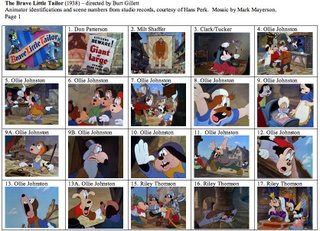
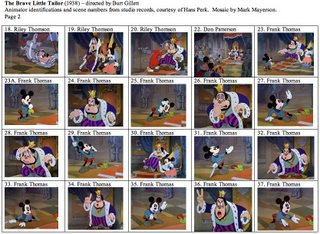
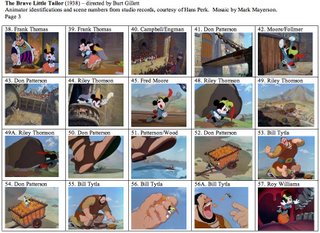
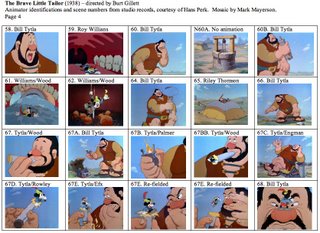
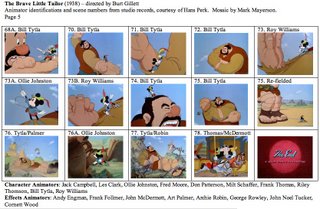 Courtesy of Hans Perk, here's the animator breakdown for The Brave Little Tailor. More on this cartoon later.
Courtesy of Hans Perk, here's the animator breakdown for The Brave Little Tailor. More on this cartoon later.
Subscribe to:
Posts (Atom)


